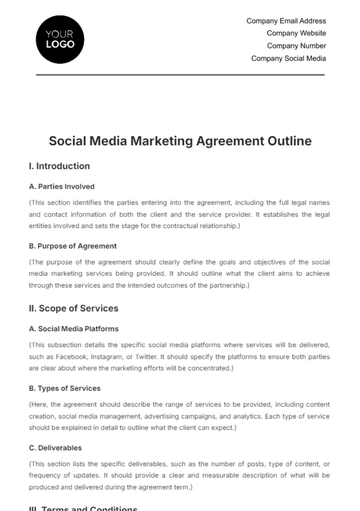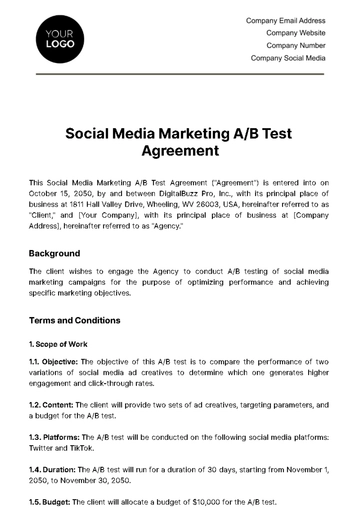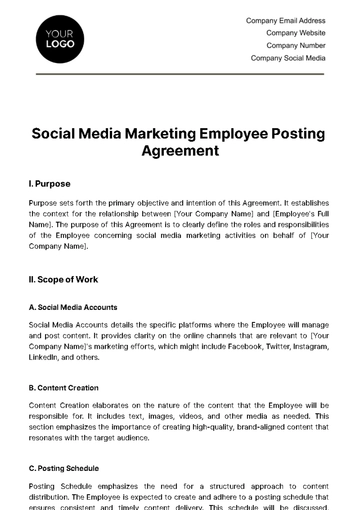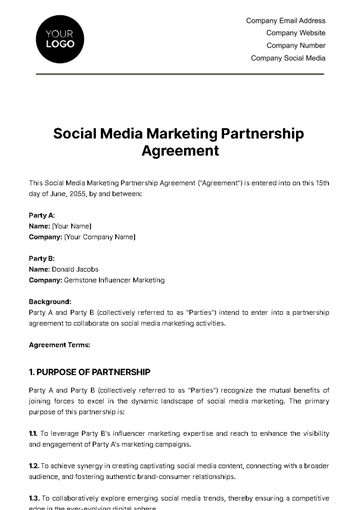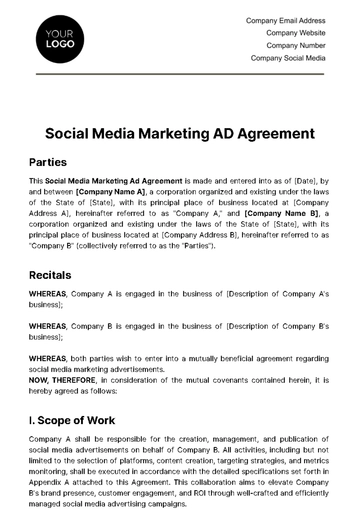Free Social Media Marketing Agreement Outline
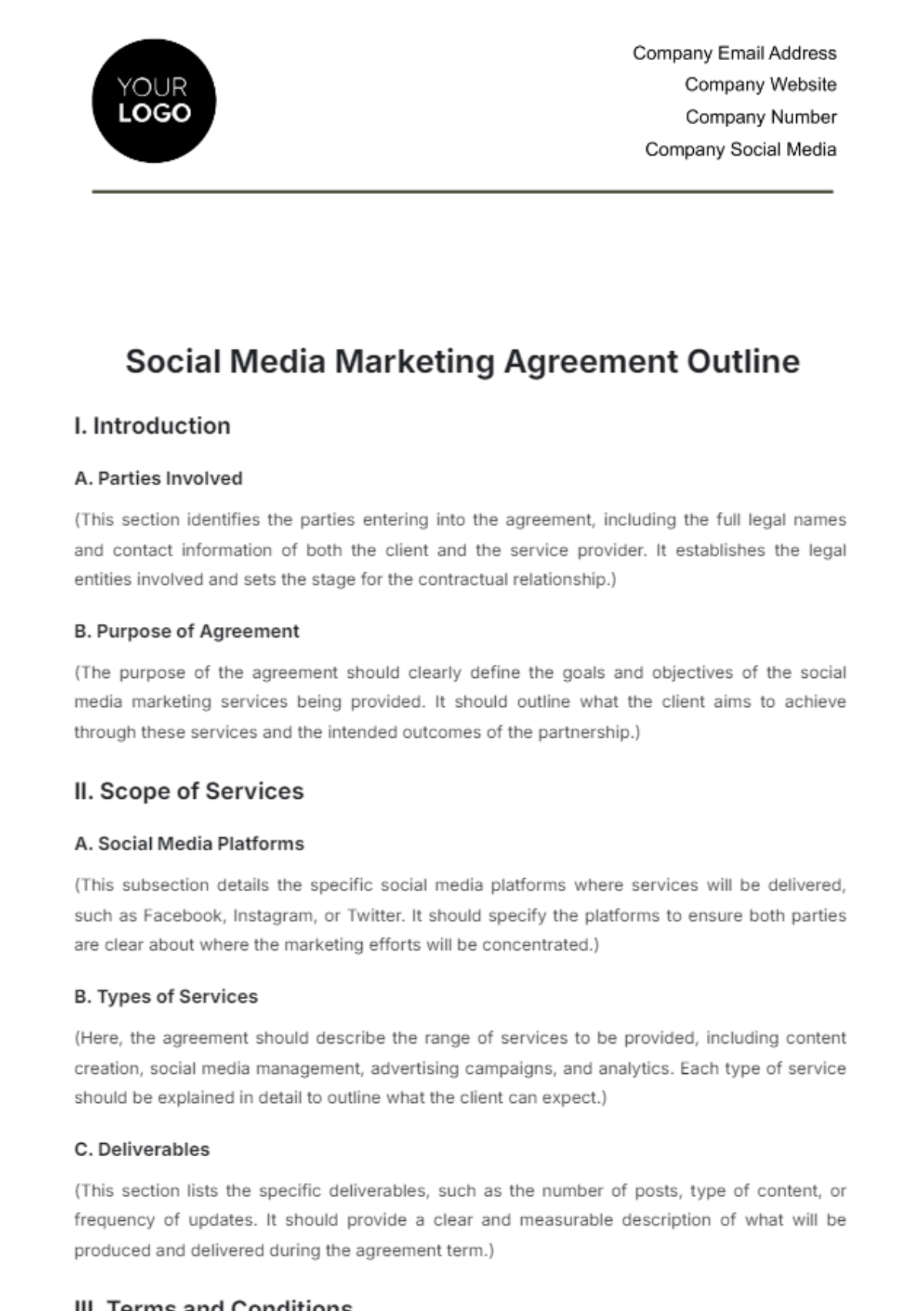
I. Introduction
A. Parties Involved
(This section identifies the parties entering into the agreement, including the full legal names and contact information of both the client and the service provider. It establishes the legal entities involved and sets the stage for the contractual relationship.)
B. Purpose of Agreement
(The purpose of the agreement should clearly define the goals and objectives of the social media marketing services being provided. It should outline what the client aims to achieve through these services and the intended outcomes of the partnership.)
II. Scope of Services
A. Social Media Platforms
(This subsection details the specific social media platforms where services will be delivered, such as Facebook, Instagram, or Twitter. It should specify the platforms to ensure both parties are clear about where the marketing efforts will be concentrated.)
B. Types of Services
(Here, the agreement should describe the range of services to be provided, including content creation, social media management, advertising campaigns, and analytics. Each type of service should be explained in detail to outline what the client can expect.)
C. Deliverables
(This section lists the specific deliverables, such as the number of posts, type of content, or frequency of updates. It should provide a clear and measurable description of what will be produced and delivered during the agreement term.)
III. Terms and Conditions
A. Duration of Agreement
(The agreement should specify the start and end dates of the engagement, defining the period during which services will be rendered. This helps establish a clear timeframe for both parties to manage expectations and scheduling.)
B. Payment Terms
(This subsection outlines the total fee for the services, payment schedule, and acceptable payment methods. It should also include details about any deposits or installment payments to ensure clarity on financial arrangements.)
C. Revisions and Amendments
(The process for requesting changes or additional services should be defined, including how requests are handled and any associated costs. This ensures both parties understand how modifications to the agreement can be made.)
IV. Responsibilities of Each Party
A. Client’s Responsibilities
(The client’s responsibilities should include providing necessary resources, access, and information required for the service provider to perform their duties effectively. This ensures the service provider has what they need to deliver on their commitments.)
B. Service Provider’s Responsibilities
(This section details the service provider’s obligations, including delivering services as outlined in the agreement and maintaining regular communication with the client. It clarifies what is expected from the service provider to meet the client's needs.)
V. Confidentiality and Data Protection
A. Confidential Information
(This subsection defines what constitutes confidential information and how it should be handled by both parties. It ensures that sensitive information shared during the engagement is protected and used appropriately.)
B. Data Protection
(Compliance with applicable data protection laws and regulations should be outlined to ensure the handling of personal data is legal and secure. This section helps protect both parties from potential legal issues related to data privacy.)
VI. Termination
A. Termination Conditions
(Conditions under which the agreement can be terminated by either party should be specified, including any breaches or failures to meet obligations. This provides a clear understanding of when and how the agreement can be ended.)
B. Notice Period
(This section specifies the required notice period for terminating the agreement, allowing both parties time to adjust to the termination. It ensures that the termination process is orderly and gives sufficient time for transition.)
VII. Intellectual Property
A. Ownership of Content
(The agreement should specify who owns the rights to the content created under the agreement, including any intellectual property rights. This clarifies the ownership and usage rights of the content produced during the engagement.)
B. Use of Client’s Intellectual Property
(Permissions and limitations regarding the use of the client’s intellectual property by the service provider should be outlined. This ensures that any use of the client’s materials is authorized and does not infringe on their rights.)
VIII. Dispute Resolution
A. Dispute Resolution Process
(Procedures for resolving conflicts or disputes between the parties should be described, including mediation or arbitration options. This section provides a framework for addressing any issues that arise during the term of the agreement.)
B. Governing Law
(The jurisdiction and applicable law governing the agreement should be specified, determining which legal system will apply. This ensures that both parties are aware of the legal context in which any disputes will be resolved.)
IX. Miscellaneous
A. Force Majeure
(Conditions under which performance may be excused due to unforeseen events, such as natural disasters or pandemics, should be detailed. This protects both parties from being held accountable for circumstances beyond their control.)
B. Entire Agreement
(A statement that the agreement constitutes the entire understanding between the parties, superseding any prior agreements or discussions. This ensures that all terms and conditions are included in one document and that no other agreements are implied.)
C. Signatures
(Signature lines for both parties to execute the agreement, indicating their acceptance and commitment to the terms outlined. This formalizes the agreement and makes it legally binding.)
- 100% Customizable, free editor
- Access 1 Million+ Templates, photo’s & graphics
- Download or share as a template
- Click and replace photos, graphics, text, backgrounds
- Resize, crop, AI write & more
- Access advanced editor
Utilize Template.net's Social Media Marketing Agreement Outline Template to streamline your social media engagements. Fully editable and customizable, this template lets you tailor agreements to your specific needs effortlessly. Enhance your workflow with the AI Editor Tool for precise adjustments and a professional finish, ensuring clear, effective contracts every time.
You may also like
- Lease Agreement
- Non Compete Agreement
- Rental Agreement
- Prenuptial Agreement
- Non Disclosure Agreement
- Operating Agreement
- Hold Harmless Agreement
- LLC Operating Agreement
- Arbitration Agreement
- Purchase Agreement
- Residential Lease Agreement
- Executive Agreement
- Confidentiality Agreement
- Contractor Agreement
- Partnership Agreement
- Postnuptial Agreement
- Collective Bargaining Agreement
- Loan Agreement
- Roommate Agreement
- Commercial Lease Agreement
- Separation Agreement
- Cohabitation Agreement
- Room Rental Agreement
- Child Custody Agreement
- Employee Agreement
- License Agreements
- Settlement Agreement
- Joint Venture Agreement
- Indemnity Agreement
- Subordination Agreement
- Sales Agreement
- Agreements Between Two Parties
- Business Agreement
- Real Estate Agreement
- HR Agreement
- Service Agreement
- Property Agreement
- Agreement Letter
- Restaurant Agreement
- Construction Agreement
- Finance Agreement
- Marketing Agreement
- Payment Agreement
- Investment Agreement
- Management Agreement
- Nonprofit Agreement
- Software Agreement
- Startup Agreement
- Agency Agreement
- Copyright Agreement
- Collaboration Agreement
- Reseller Agreement
- Car Rental Agreement
- Cleaning Services Agreement
- Consultant Agreement
- Deed Agreement
- Car Agreement
- Equipment Agreement
- Shares Agreement
- Data Sharing Agreement
- Advertising Agreement
- School Agreement
- Franchise Agreement
- Event Agreement
- Travel Agency Agreement
- Vehicle Agreement
- Board Resolution Agreement
- Land Agreement
- Binding Agreement
- Tenancy Agreement
- Exclusive Agreement
- Development Agreement
- Assignment Agreement
- Design Agreement
- Equity Agreement
- Mortgage Agreement
- Purchase and Sale Agreement
- Shareholder Agreement
- Vendor Agreement
- Royalty Agreement
- Vehicle Lease Agreement
- Hotel Agreement
- Tenant Agreement
- Artist Agreement
- Commission Agreement
- Consignment Agreement
- Debt Agreement
- Recruitment Agreement
- Training Agreement
- Transfer Agreement
- Apprenticeship Agreement
- IT and Software Agreement
- Referral Agreement
- Resolution Agreement
- Waiver Agreement
- Consent Agreement
- Partner Agreement
- Social Media Agreement
- Customer Agreement
- Credit Agreement
- Supply Agreement
- Agent Agreement
- Brand Agreement
- Law Firm Agreement
- Maintenance Agreement
- Mutual Agreement
- Retail Agreement
- Deposit Agreement
- Land Purchase Agreement
- Nursing Home Agreement
- Supplier Agreement
- Buy Sell Agreement
- Child Support Agreement
- Landlord Agreement
- Payment Plan Agreement
- Release Agreement
- Research Agreement
- Sponsorship Agreement
- Buyout Agreement
- Equipment Rental Agreement
- Farm Agreement
- Manufacturing Agreement
- Strategic Agreement
- Termination of Lease Agreement
- Compliance Agreement
- Family Agreement
- Interior Design Agreement
- Ownership Agreement
- Residential Lease Agreement
- Retainer Agreement
- Trade Agreement
- University Agreement
- Broker Agreement
- Dissolution Agreement
- Funding Agreement
- Hosting Agreement
- Investor Agreement
- Memorandum of Agreement
- Advisory Agreement
- Affiliate Agreement
- Freelancer Agreement
- Grant Agreement
- Master Service Agreement
- Parking Agreement
- Subscription Agreement
- Trust Agreement
- Cancellation Agreement
- Horse Agreement
- Influencer Agreement
- Membership Agreement
- Vacation Rental Agreement
- Wholesale Agreement
- Author Agreement
- Distributor Agreement
- Exchange Agreement
- Food Agreement
- Guarantee Agreement
- Installment Agreement
- Internship Agreement
- Music Agreement
- Severance Agreement
- Software Development Agreement
- Storage Agreement
- Facility Agreement
- Intercompany Agreement
- Lending Agreement
- Lodger Agreement
- Outsourcing Services Agreement
- Usage Agreement
- Assurance Agreement
- Photography Agreement
- Profit Sharing Agreement
- Relationship Agreement
- Rent To Own Agreement
- Repayment Agreement
- Volunteer Agreement
- Co Parenting Agreement
- HVAC Agreement
- Lawn Care Agreement
- SAAS Agreement
- Work from Home Agreement
- Coaching Agreement
- Protection Agreement
- Security Agreement
- Repair Agreement
- Agreements License
